Key Insights
- SKALE is a network of EVM-compatible, application-specific sidechains, connected to Ethereum and secured by a pool of rotating validators.
- SKALE has zero gas fees, instead relying on inflation and subscription fees for SKALE chains to incentivize and reward validators.
- Before the launch of SKALE V2 in Q2’22, which brought interoperability between SKALE’s dApp chains, network activity was close to zero.
- Network activity has dramatically increased since the launch of V2, but it is almost entirely driven by one gaming dApp chain CryptoBlades.
Although a case remains to be made for general purpose, monolithic blockchains, there’s a growing belief that alternative, modular blockchain designs are necessary to scale blockchains in the most secure, decentralized, and efficient manner. At the moment, the two most popular alternatives that rely on modularity are what have become commonly known as “modular blockchains” and application-specific blockchains. Compared to monolithic blockchains, which provide all four of consensus, execution, settlement, and data availability, modular blockchains rely on a separate layer for one or more of these functions. Much of the current modular design focus is centered around scaling Ethereum using Layer-2 rollups. Application-specific blockchains are networks of individual blockchains that are connected in some manner. Rather than having one general purpose blockchain with a DEX, lending protocol, NFT marketplace, etc., each application or group of applications has its own blockchain. This approach has several benefits, including providing application developers with more flexibility and sovereignty over their protocol and not leaking value in the form of maximum extractable value (MEV) to the underlying blockchain.
SKALE has primarily chosen the application-specific blockchain design alternative. SKALE also incorporates some Ethereum scaling aspects, just not in the modular sense described above. SKALE is a network of configurable sidechains connected to the Ethereum Mainnet via a set of smart contracts that manages staking, validator orchestration, and other core network functions. Although SKALE is dependent on Ethereum, it does not fully inherit security from Ethereum. Instead, it has an independent validator set that runs its own consensus mechanism, similar to Polygon’s Proof-of-Stake network. Thus, SKALE does not scale Ethereum through the modular design of leveraging Ethereum for one of the four core blockchain functions mentioned above. Rather, it aims to scale Ethereum by providing users and developers with an EVM-compatible environment that can process more transactions at a lower cost. The SKALE network itself consists of EVM-compatible, application-specific blockchains, which recently became interoperable after an upgrade Q2’22. Since the upgrade, activity on SKALE has taken off, with users and developers taking advantage of the zero gas fees on the network. SKALE’s network activity and ecosystem is still lagging behind Ethereum scaling solutions like Polygon, Optimism, and Arbitrum and app-specific blockchains like Cosmos and Polkadot. However, with SKALE’s combination of zero gas fees, Ethereum scaling, and application-specific blockchains, it is poised to continue its recent rapid growth.
Background
SKALE was co-founded in 2018 by Jack O’Holleran and Stan Kladko, both of whom were Silicon Valley technology executives and entrepreneurs for 10-plus years. The team received initial funding from Signia Ventures and Floodgate, and later raised $17.1 million near the end of 2019 from investors including Multicoin Capital, Winklevoss Capital, and ConsenSys Labs. Since launch, two groups formed to help support the SKALE network: SKALE Labs, who contribute to the open-source protocol and initiate growth efforts, and the Network of Decentralized Economics (N.O.D.E.) Foundation, a non-profit entity that oversees the grants program and other treasury efforts.
In 2020, SKALE rolled out its mainnet in three stages, beginning with a restricted, bare-bones version on June 30. Running alongside the rollout of SKALE’s network was the public distribution of SKALE’s native token, SKL. In September, 2.5% of SKL’s total supply was publicly sold at a valuation of $210 million on ConsenSys’ new Codefi Activate platform, with almost 4,000 participants across 90 countries. The platform used a “proof-of-use” framework, requiring token purchasers to stake or delegate their SKL tokens for two months before being able to redeem or transfer them. Sale participants were able to begin staking their tokens upon the second stage of the mainnet rollout on October 1, allowing their tokens to unlock along with the third and final stage on December 1. Since launch, SKALE has had one major upgrade (SKALE V2), which added interoperability between SKALE’s dApp chains in Q2’22.
Technology
Network Architecture
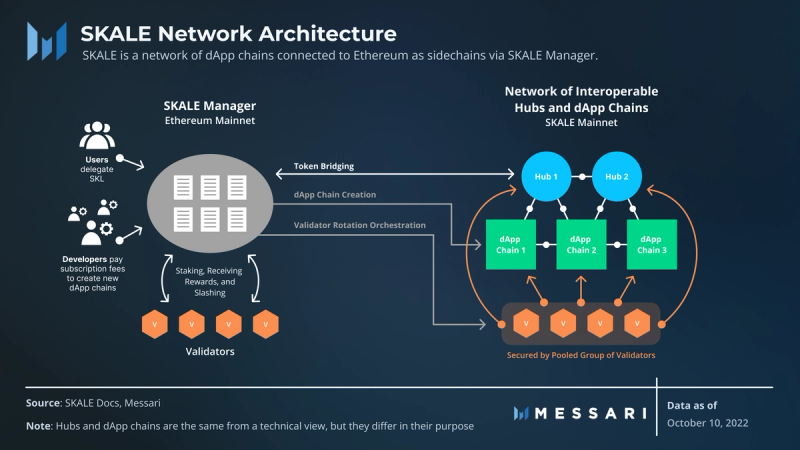
SKALE is a network of application-specific EVM blockchains (SKALE chains) connected to the Ethereum Mainnet. SKALE chains can also be general purpose, with the first one set to launch in the near future. SKALE Manager, a set of smart contracts deployed on Ethereum, provides an entry point into the SKALE network for validators (via staking) and developers (via paying a subscription fee to create a new SKALE chain). Beyond staking and blockchain creation, SKALE Manager handles other core network functions such as node selection and rotation, token bridging, and, pending a future governance vote, slashing.
Consensus
Participants
SKALE network’s consensus is carried out by its validators. Each validator node consists of a node core and virtualized subnodes. The node core manages a node’s subnodes, tracks peer nodes, and provides node owners with an interface to withdraw, deposit, stake, and claim tokens. Nodes are segmented into up to 128 virtualized subnodes via a containerized architecture. Containers are all-inclusive packages of software allowing it to be easily run in any environment. Containers became popular in cloud computing.
For SKALE, the containerized structure brings modularity to its nodes. A validator can have its various subnodes acting as validators for up to eight different SKALE chains. Thus, all SKALE chains are secured by a rotating set of the network’s pooled virtualized subnodes.
In order to become a SKALE validator, one needs to stake a minimum 20 million SKL ($675,000 at current prices) and meet the network’s hardware requirements.
Mechanism
SKALE is a Proof-of-Stake network that uses a modified Asynchronous Binary Byzantine Agreement (ABBA) consensus mechanism. ABBA is leaderless, therefore, unlike many other consensus mechanisms there is not a designated block proposer each round. Because any node can propose a block at any time, there is no fixed period of extra time allocated for block proposing, speeding up the time-to-finality of a transaction. SKALE’s asynchronous design ensures the network can continue processing transactions even if some nodes go offline.
If a node wants to propose a block, it needs to send it to all of its peer nodes. Since all nodes can propose and send blocks simultaneously, nodes only send hashes of the block in order to not overload the network. If a node approves of the block, it sends it back to the proposer with a signature. Once the block proposer receives signatures from more than two-thirds of the nodes, it creates a supermajority signature and broadcasts the block and signature to all virtualized subnodes. If there are multiple blocks at the same time that have received supermajority signatures, one proposal is pseudo-randomly picked to be committed. After the winning block is chosen, there is one more round of receiving signatures from all virtualized subnodes — if more than two-thirds are received then the block is committed.
Validator Rewards and Penalties
All token emissions and subscription fees from each chain go to one bounty pool. Every month, the bounty pool is split evenly among all validators assuming they meet performance criteria. Nodes are audited by 24 peer nodes. These track metrics such as uptime and latency and give nodes a monthly score based on the results. After removing the bottom and top four scores, a node is given a binary score based on the average of the remaining 16 scores. This dictates whether or not a node is able to claim their rewards. If a node does not pass the criteria, their unclaimed tokens are sent to the N.O.D.E. Foundation.
Currently, there is no slashing mechanism or penalty for validator misbehavior. There are plans to put forth a proposal to enact slashing later this year, once on-chain voting is enabled. Under the proposed system, if validators misbehave, their stake will be transferred to an escrow contract. An on-chain vote can return the funds to the validator if the voters believe that the validator did not actually misbehave.
Threshold Encryption
Threshold encryption conceals information from individuals, requiring those individuals (past a certain threshold) to work together to reveal the information. SKALE uses Boneh-Lynn-Schacham (BLS) threshold signatures throughout its consensus mechanism, transaction execution, bridging, and cross-chain communication. For example, all transactions are encrypted before entering the mempool and their contents are only revealed after a block has received network consensus and been executed. This prevents validators from extracting value from users by reordering transactions in the mempool.
SKALE Chain Details
Subscription Fees
SKALE chains allow developers to launch EVM-compatible application-specific chains.
In order to create a chain, a developer must pay a yearly subscription fee in SKL. In the future, developers will be able to select customizations including network size, transaction throughput, storage capacity, and enhanced security features.
The cost of a SKALE chain is dynamic, adjusting based on overall demand and supply for SKALE chains. The network aims to have 70% of its resources utilized at any given time. If there are too few validators who are able to support another SKALE chain when a new SKALE chain is launched, it could be deduced which validators will be assigned to the new chain in the first round. The cost of a SKALE chain decreases by 2% for every percentage point the network’s load is below 70%. The cost increases by 4% for every percentage point the network’s load is above 70%. Given a network load of 70%, a new SKALE chain would cost around $240,000 for a year.
The subscription fee serves as a payment for renting the network’s resources, namely its shared validator set. It also negates the economical need for gas fees, as validators are instead rewarded from the subscription fee. However, there are security concerns, including network attacks like DDoS, with a zero fee system for end users. To combat this, SKALE still has a gas token (sFUEL), but it does not have any monetary value. Users are able to receive sFUEL from token faucets or Discord. However, there are methods in place, like captchas or time intervals between receiving sFUEL, to prevent actors from receiving a large amount of sFUEL at once. Along with restricting the amount of sFUEL a user can receive at once, SKALE has other measures to help defend against spam, such as limiting the overall gas consumption rate on SKALE chains.
Performance
Each SKALE chain can theoretically handle around 120 transactions-per-second (tps) while in sequential mode (finalizing one transaction from a single address before another can be processed – preferable for financial applications) and up to 500 tps in multi-transaction mode (can include more than one transaction from a single address in a block – preferable for gaming applications). For reference, Polygon PoS can theoretically reach around 7,000 tps. However, this is split among all dApps on the network.
Interoperability
When SKALE originally launched, users were not able to bridge between SKALE chains. Instead, users had to use Ethereum as an intermediary. Bridging was both inconvenient and costly, as users would have to pay several Ethereum gas fees. Along with SKALE V2, SKALE Labs launched the interchain messaging agent (IMA) bridge.
The IMA bridge brought interchain communication, allowing the gas free transfer of assets and messages between SKALE chains. It uses the same mechanisms for security as SKALE’s consensus protocol, namely BLS encryption and a threshold of validator signatures.
However, to give them more control over their network’s bridging (including whitelisting different third party bridges, applications, or tokens), SKALE chain owners employ multi-sigs on top of the underlying bridging architecture. Depending on the level of control the chain owner gives to the multi-sig (for example, it could be able to update smart contracts affecting the bridge), bridge security could be reduced to the security of the multi-sig instead of the underlying bridge protocol. Chain owners plan on eventually moving control to on-chain governance to minimize these attack vectors.
Tokenomics
SKALE’s native token SKL is used for security (via validator staking) and SKALE chain subscription fees. In the future, all SKL holders will be able to participate in on-chain governance. SKL has a fixed total supply of 7 billion tokens.
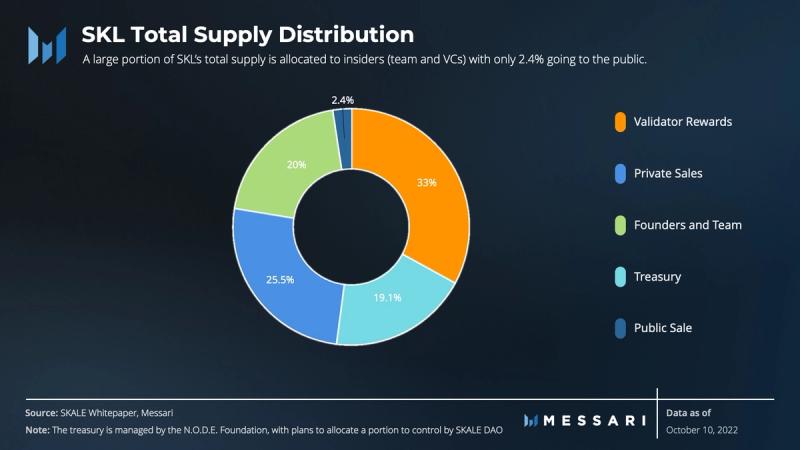
A third of SKL’s total supply is allocated to validators in the form of inflation block rewards. The majority of the remaining allotment is for insiders, divided up among the founders, core team, and participants in the three private sales. Only 2.4% of the total supply was allocated to the public.
The treasury is split into three funds, all managed by the N.O.D.E. Foundation. The funds have slightly different purposes, but all are generally used for grants and other network operations. The Foundation is expected to release a transparency report on past token distributions every six months beginning in December. There are plans to transfer a large share of these funds to a DAO in the near future.
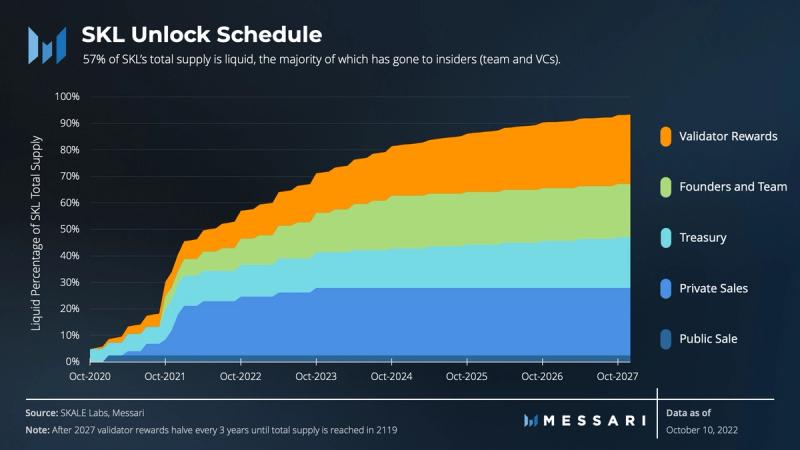
At time of writing, 57% of SKL’s total supply is liquid. 95% of the total supply will be liquid by October 2028. The total supply will be fully liquid by 2119.
So far, about 10% of the total supply has been distributed to validators. In the next five years, another 16% will be distributed. Following that, validator rewards will halve every three years until the remaining 7% of the total supply has been distributed.
Notably, 10% of the total supply has also been distributed to the founders and core team. Their remaining 10% allotment will be unlocked every three months over the next two years.
Of total supply, 11.9% has been distributed to the treasury. The N.O.D.E. Foundation will receive the remaining 7% over the next five years.
There were three pre-launch SKL private sales. Rounds 2 (10.1% of total supply; tokens sold at $0.0099-$0.0125) and round 3 (5.4% of total supply; tokens sold at $0.0152) have fully unlocked. Round 1 (10% of total supply; tokens sold at $0.0034) will be fully vested after two more unlocks of 1.67% of the total supply on Apr 1, 2023 and Oct 1, 2023.
Public sale tokens (2.4% of the total supply) were all liquid upon mainnet launch.
Current State of SKALE Network and Ecosystem
SKALE Chains Activity
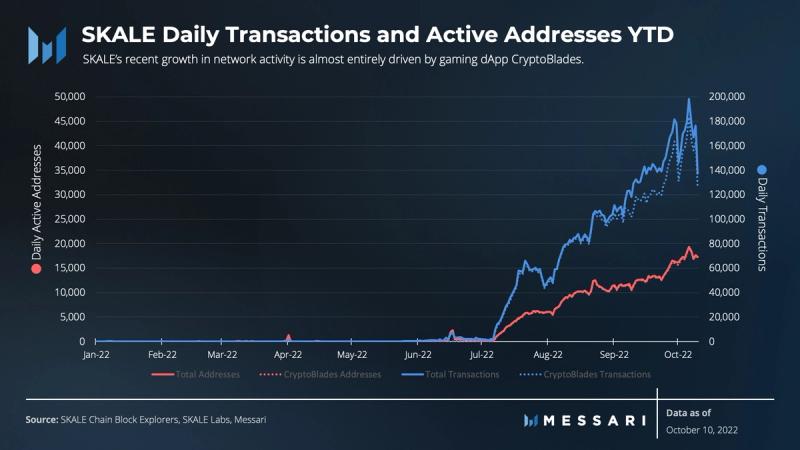
Prior to SKALE V2, SKALE chains were siloed which fragmented liquidity and forced each application to individually onboard many different third party servicers, like oracles, data indexers, and fiat on/off ramps.
From the beginning of 2022 up to the launch of V2, SKALE chains averaged a combined 51 daily transactions and 28.5 active addresses.
V2 not only brought interoperability between chains but also distinguished SKALE chains into “Hubs” and “dApp Chains.” From a technical standpoint, Hubs and dApp chains are the same, but they differ in their purpose. Hubs are chains that provide key services to other dApp chains and receive additional support from the Foundation and ecosystem funds. This allows dApp chains to focus on their project, rather than needing to onboard price oracles, build their own liquidity pools, and more. Instead, they can rely on Hubs that provide these services in a standardized manner across the ecosystem.
Since the launch of V2, SKALE chains have averaged a combined 64,725 daily transactions and 6607.5 unique addresses. However, almost all of that activity has been driven by one gaming dApp chain, CryptoBlades. Since CryptoBlades launched, it has accounted for 92% of SKALE’s total transactions and 97.6% of its daily active addresses. Additionally, SKALE has lost market share since V2 – according to CoinMarketCap its circulating market cap rank has dropped from 109th to 170th since the launch of V2.
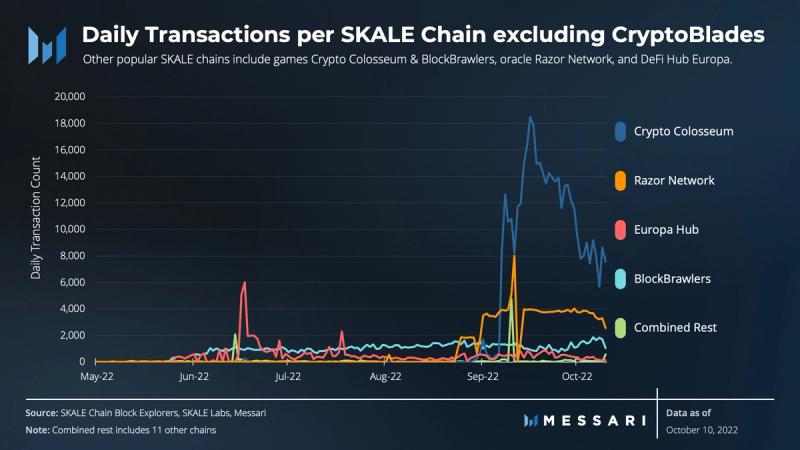
Hubs: Europa and Calypso
Europa is SKALE’s DeFi Hub, led by Ruby Exchange. The team behind Ruby Exchange had been working with SKALE Labs to create Europa and integrate their protocol into the chain leading up to the announcement of SKALE V2. The chain officially launched in May 2022, garnering some early traction, which has since died down.
Ruby Exchange is a decentralized exchange featuring a constant product automated market maker (CP-AMM). The protocol uses NFTs that are distributed in paid raffles to offer additional benefits to users, such as reduced trading fees. The exchange currently has $2.1 million in total value locked (TVL) and has done $6.5 million all time in volume.
Europa is also currently the Hub for bridging tokens between Ethereum Mainnet and SKALE dapp chains. The bridge is controlled by a 3/5 multi-sig layered on top of the underlying IMA bridge. The five multi-sig signers are:
- Ruby Exchange
- Impossible Finance, a launchpad not built on SKALE that facilitated the RUBY IDO on Binance Smart Chain
- Boot Finance, a DeFi protocol that planned to build on SKALE prior to a hack and that has not had any activity on its Twitter or Medium account since May 19
- 01Node and Stakin, both multi-chain staking providers that have 1.52% and 0.77% of SKALE’s total validator share, respectively
Since launch, Europa has averaged 513 daily transactions and 92 daily active addresses.
SKALE’s second Hub is Calypso, which is designed to centralize NFT liquidity and bridging. Calypso aims to be the initial location for all SKALE NFT launches, SKALE’s main NFT marketplace, and the intermediary for bridging NFTs between Ethereum and SKALE as well as between SKALE dapp chains. The Calypso Hub is being led by MyLilius, who built the MyLilius Wallet for SKALE. Like with Europa, MyLilius plans to turn Calypso into a community-owned Hub.
Calypso deployed in mid-July, averaging 72 daily transactions and 13 daily active addresses since then. However, the Hub has not officially been announced, and the team expects activity to significantly increase following the public launch.
dApp Chains
Beyond the two Hubs, there are currently 11 live dApp chains. These dApp chains span various sectors including DeFi, NFTs, gaming as well as other Web3 platforms such as decentralized commerce and monetized video streaming.
So far, gaming applications have been the most popular dApp chains on SKALE. CryptoBlades is a multi-chain play-to-earn PVP game that has, as mentioned above, accounted for almost all of SKALE’s network activity since launch. Despite the high transaction and user count, CryptoBlades has only facilitated around $1,225 in secondary trading volume in the past 30 days on SKALE. Crypto Colosseum is a multi-chain game that launched its multiplayer board game, Delph’s Table, on a SKALE dApp chain earlier in September. It has averaged 3,240 daily transactions and 15 daily active addresses since launch. Block Brawlers is a play-to-earn role playing game (P2E RPG) whose ongoing community sale has so far raised around $85,000. So far, it has averaged 1,048 daily transactions and 42 daily active addresses.
Validators
There are currently 50 validators securing the network. They stake a combined 2.65 billion SKL ($87 million at current prices), which has slowly decreased from the peak in November 2020 of 3.15 billion SKL. The top five validators together control 35% of the network. Furthermore the third highest-staked validator co-runs the fourth highest-staked node with another staking provider. In total, there are 835 unique delegators staking their SKL with network validators. In order to delegate, one has to lock-up their funds for 60 days.
Roadmap
Protocol Improvements
On the protocol layer, SKALE Labs is working to increase the network’s decentralization and security. As mentioned earlier, there are plans to allow all SKL holders to participate in SKALE governance via on-chain voting. Developers and validators are currently finalizing the details of the voting model. It is planned to go live in Q4’22. Once it’s enabled, validator slashing will be put to a vote.
SKALE Labs also plans to implement a modified “roll back” mechanism to add another layer of security. The feature will automatically divert any bridge transfers from addresses without prior transactions to an escrow address on Ethereum. Each SKALE chain owner will choose who has control over their escrow address, whether it be a multi-sig or on-chain governance. The mechanism will allow chain owners to set a function so that all bridge transfers over a chosen value are also sent to the escrow address for a set amount of time. The feature is currently being audited and is expected to be implemented within the next several months.
Ecosystem Improvements
SKALE aims to support 30 chains by the end of the year. Beyond the 13 chains already live, there are currently 6 more that have either been announced or have begun development. SKALE also hopes to introduce “Community Chains” on top of Hubs and dApp Chains. Community Chains will group together several similar applications into one chain if those applications do not feel the need to pay for security for their own entire chain. There are plans to build a Community Chain powered by zero-knowledge technology, with more details to be released soon.
Another core focus of SKALE Labs and the Foundation during Q4’22 will be partnering with third-party service providers like Covalent, a protocol that indexes blockchain data so it can be queried by others. SKALE network’s lack of on-chain data indexing has prevented it from being featured on third-party data sites like DeFiLlama and DappRadar. In general, the only publicly visible on-chain data for SKALE is a high-level dashboard on SKALE’s website. Thus, these partnerships and integrations will bring more accessibility to SKALE’s on-chain data and overall transparency to the network.
Growth Strategy
Ecosystem partnerships and growth will be spearheaded mainly by the N.O.D.E. Foundation. In February 2022, the Foundation announced a $100 million ecosystem incentive program. It originally allocated $5 million for gaming project grants. Recently in September, it allocated 10 million SKL ($328,500 at time of writing) from it for an NFT grant program.
Summary
SKALE allows developers to build EVM-compatible application-specific blockchains with unique features including zero gas fees and threshold encryption. Developers do not have to bootstrap their own validator set, but instead rent them from a rotating pool of SKALE validators. However, lack of interoperability between SKALE chains prevented the network from gaining traction in its first year and a half following launch. The upgrade to V2 removed this key drawback and kicked off exponential growth within SKALE’s network and ecosystem.
However, SKALE still has a long way to go to catch up to its competitors. In the short-term, enabling on-chain governance by all SKL token holders and integrating with on-chain data indexers will help increase SKALE’s decentralization and transparency. The N.O.D.E. Foundation will need to successfully allot the treasury and ecosystem fund to projects that will bring users to SKALE, as at the moment all SKALE activity is dominated by one game. If SKALE Labs and the N.O.D.E. Foundation can successfully implement these technical and ecosystem improvements, SKALE is well-positioned to continue its growth.











